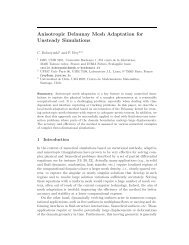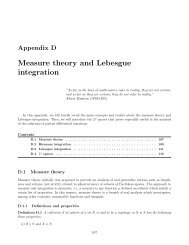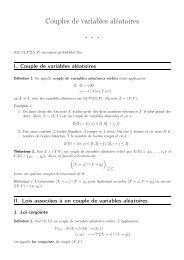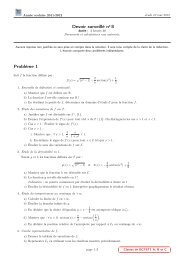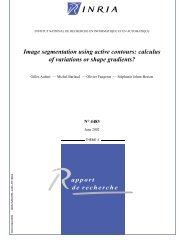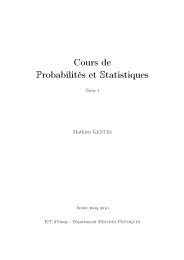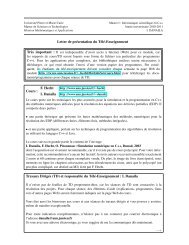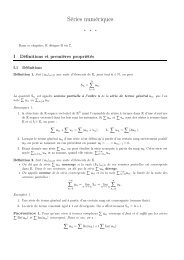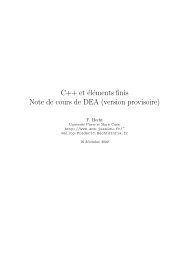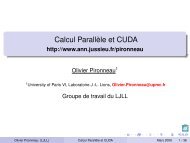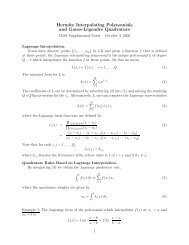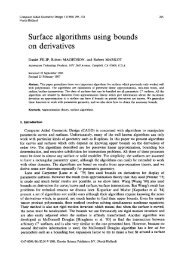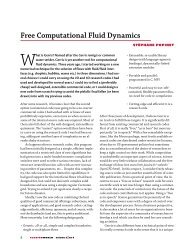pdf file
pdf file
pdf file
You also want an ePaper? Increase the reach of your titles
YUMPU automatically turns print PDFs into web optimized ePapers that Google loves.
24 M. LEWIN, P. T. NAM, S. SERFATY, AND J. P. SOLOVEJ<br />
then Tre −β0(K+V) < ∞ for all β0 > 0, due to [18, Theorem 1] and the<br />
operator inequality √ −∆ + |x| ≥ � −∆+|x| 2 in L 2 (R d ). The latter is a<br />
consequence of the operator monotonicity of the square root and the fact<br />
that √ −∆|x|+|x| √ −∆ ≥ 0 in L 2 (R d ), see [28, Theorem 1].<br />
Second, in [50, Theorem 1] the authors provided upper and lower bounds<br />
on the classical free energy at nonzero temperatures, which coincide when<br />
β −1 → 0. Inthe quantumcase weare able to identify precisely thelimit (36)<br />
even when β −1 > 0, which is given by the Bogoliubov Hamiltonian.<br />
4. Operators on Fock spaces<br />
In this preliminary section, we introduce some useful operators on Fock<br />
spaces and we consider the unitary UN defined in (18) in detail.<br />
For any vector f ∈ H, we may define the annihilation operator a(f) and<br />
the creation operator a∗ (f) on the Fock space F = �∞ N=0HN by the following<br />
actions<br />
⎛<br />
a(f) ⎝ �<br />
σ∈SN<br />
a ∗ ⎛<br />
(fN) ⎝ �<br />
f σ(1) ⊗...⊗f σ(N)<br />
σ∈SN−1<br />
⎞<br />
⎠ = √ N �<br />
f σ(1) ⊗...⊗f σ(N−1)<br />
⎞<br />
σ∈SN<br />
⎠ = 1<br />
√ N<br />
� �<br />
f,fσ(1) fσ(2) ⊗...⊗f σ(N),(37)<br />
�<br />
σ∈SN<br />
f σ(1) ⊗...⊗f σ(N) (38)<br />
for all f,f1,...,fN in H, and all N = 0,1,2,.... These operators satisfy the<br />
canonical commutation relations<br />
[a(f),a(g)] = 0, [a ∗ (f),a ∗ (g)] = 0, [a(f),a ∗ (g)] = 〈f,g〉H. (39)<br />
Note that when f ∈ H+, then a(f) and a∗ (f) leave F+ invariant, and<br />
hence we use the same notations for annihilation and creation operators on<br />
F+. The operator-valued distributions a(x) and a∗ (x) we have used in (12)<br />
can be defined so that for all f ∈ H+,<br />
�<br />
a(f) = f(x)a(x)dx and a ∗ �<br />
(f) = f(x)a ∗ (x)dx.<br />
Ω<br />
To simplify the notation, let us denote an = a(un) and a ∗ n = a∗ (un), where<br />
{un} ∞ n=0 is an orthonormal basis for L2 (Ω) such that u0 is the Hartree minimizer<br />
and un ∈ D(h) for every n = 1,2,.... Then the Bogoliubov Hamiltonian<br />
defined in (12) can be rewritten as<br />
H = �<br />
m,n≥1<br />
〈um,(h+K1)un〉 L 2 (Ω) a ∗ man + 1<br />
2 〈um ⊗un,K2〉 L 2 (Ω 2 ) a ∗ ma ∗ n<br />
Ω<br />
+ 1<br />
2 〈K2,um ⊗un〉 L 2 (Ω 2 ) aman. (40)<br />
The sums here are not convergent in the operator sense. They are well defined<br />
as quadratic forms on the domain given in (14). Since the so-obtained<br />
operator is bounded from below (by Theorem 1), it can then be properly<br />
defined as a self-adjoint operator by the Friedrichs extension.



